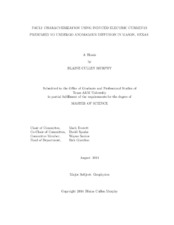| dc.description.abstract | A tensorial (9-component) controlled source electromagnetic survey over an oblique slip fault in Mason County, Texas was acquired and the data were analyzed in order to characterize the structure of the fault and observe the diffusion of the induced currents in a fractured medium. The fault juxtaposes a Cambrian sandstone against Precambrian granite and both are highly resistive media that are not generally conducive to electromagnetic surveys.
The loop-loop method used in this project induces an eddy current system in the subsurface that moves down and out like a smoke ring. The eddy currents generate a transient magnetic field that is recorded by the receiver loop, which is stepped out from the transmitter loop at various offsets. The 9-component data set includes responses with the 3 orthogonal source orientations and 3 similar receiver orientations at each offset, and data were recorded over the fault zone along two oppositely-directed profiles.
Induced currents were presumed to diffusive anomalously in the presence of a geologically rough medium, in this case the fractured subsurface of the fault zone. Classic diffusion corresponding to a continuously differentiable medium would result in a decay of the received signal according to a t^(-5/2) power law. Deviation of the power law decay from a -5/2 slope indicates anomalous diffusion of the subsurface eddy current system. A faster decay in the transient response at long offsets was
observed, and it suggests highly resistive fractures in the fault zone at depth. A shallower decay at near offset, and for the shallower-probing vertical co-planar orientation, suggests more conductive fractures in the near surface A higher resolution 3-dimensional survey is required to rigorously test whether induced currents indeed undergo anomalous diffusion in a rough geological medium. | en |


